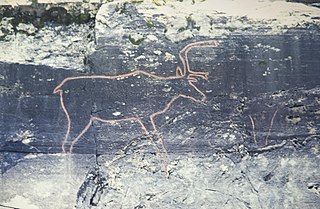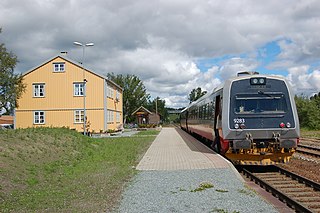Related Research Articles

Trondheim, historically Kaupangen, Nidaros, and Trondhjem, is a city and municipality in Trøndelag county, Norway. As of 2022, it had a population of 212,660. Trondheim is the third most populous municipality in Norway, and is the fourth largest urban area. Trondheim lies on the south shore of Trondheim Fjord at the mouth of the River Nidelva. Among the significant technology-oriented institutions headquartered in Trondheim are the Norwegian University of Science and Technology (NTNU), the Foundation for Scientific and Industrial Research (SINTEF), the Geological Survey of Norway (NGU), and St. Olavs University Hospital.

A nisse, tomte, tomtenisse, or tonttu is a household spirit from Nordic folklore which has always been described as a small human-like creature wearing a red cap and gray clothing, doing house and stable chores, and expecting to be rewarded at least once a year around winter solstice (yuletide), with the gift of its favorite food, the porridge.

The Norwegian Broadcasting Corporation, commonly known by its initialism NRK, is a Norwegian state-run, government-influenced radio and television broadcasting company.

Trøndelag (Urban East Norwegian:[ˈtrœ̂ndəˌlɑːɡ]; or Trööndelage is a county and coextensive with the Trøndelag region in the central part of Norway. It was created in 1687, then named Trondhjem County ; in 1804 the county was split into Nord-Trøndelag and Sør-Trøndelag by the King of Denmark-Norway, and the counties were reunited in 2018 after a vote of the two counties in 2016.
Nidaros, Niðarós or Niðaróss was the medieval name of Trondheim when it was the capital of Norway's first Christian kings. It was named for its position at the mouth of the River Nid.

The Battle of Stiklestad in 1030 is one of the most famous battles in the history of Norway. In this battle, King Olaf II of Norway was killed. During the pontificate of Pope Alexander III, the Roman Catholic Church declared Olaf a saint in 1164.
The Julekalender is a julekalender that originally aired in Christmas 1991. A Norwegian version was made in 1994, and a Finnish version appeared in 1997. It was written and performed almost entirely by a trio of Danish comedy musicians called De Nattergale with financial and technical assistance from TV2, a Danish television company. It was hugely successful at the time, causing many invented phrases from the series to enter popular culture and was later released on VHS and subsequently DVD.

The Nordland Line is a 729-kilometer (453 mi) railway line between Trondheim and Bodø, Norway. It is the longest in Norway and lacks electrification. The route runs through Trøndelag and Nordland counties, carrying a combination of commuter, long-haul passenger and freight trains. From Trondheim Central Station to Steinkjer Station the line is most heavily used, with hourly services by the Trøndelag Commuter Rail. There are three branch lines—the Stavne–Leangen Line at Leangen Station, the Meråker Line at Hell Station and the Namsos Line at Grong Station.

Central Norway is a region in Norway, comprising Trøndelag as well as parts of the Nordland and Møre og Romsdal counties.
Bergensk or Bergen dialect is a dialect of Norwegian used in Bergen, Norway. It is easy for Norwegians to recognise, as it is more distinguishable from other dialects in Vestland than, for example, the Stavanger dialect (Stavangersk) from the dialects of Rogaland, and the Trondheim dialect from Trøndelag dialects.
The Joulukalenteri is a 1997 Finnish television miniseries produced by MTV3 that was broadcast again in 1998, 2007, 2017, 2018, 2019 and 2022. It was based on the Danish series The Julekalender from 1991. A Norwegian version was made in 1994.

The petty kingdoms of Norway were the entities from which the later Kingdom of Norway was founded. Before the unification of Norway in 872 and during the period of fragmentation after King Harald Fairhair's death, Norway was divided in several small kingdoms. Some could have been as small as a cluster of villages, and others comprised several of today's counties.

The Namsos Line is a 51-kilometer-long (32 mi) railway line between the village of Medjå and the town of Namsos in Trøndelag county, Norway. The line branches off from the Nordland Line at Grong Station and runs through Grong Municipality, Overhalla Municipality, and Namsos Municipality. The line largely follows the river Namsen. The section from Grong to Skogmo is maintained, although not used for ordinary traffic. The section from Skogmo to Namsos is closed, but the infrastructure remains.

The Hell–Sunnan Line is a 105-kilometer-long (65 mi) railway line between Hell and Sunnan in Trøndelag county, Norway. The name is no longer in official use and the line is now considered part of the Nordland Line. The Hell–Sunnan Line branches from the Meråker Line at Hell and runs on the east shore of the Trondheimsfjord passing through Stjørdal Municipality, Levanger Municipality, Verdal Municipality, Inderøy Municipality, and Steinkjer Municipality.

Higher education in Norway is offered by a range of ten universities, nine specialised universities, 24 university colleges as well as a range of private university colleges. The national higher education system is in accordance with the Bologna process, with bachelor's degrees, master's degrees and doctoral degrees. Acceptance is offered after finishing upper secondary school and meeting general university admissions certification.

Nord-Trøndelag was a county constituting the northern part of the present-day Trøndelag county in Norway. It bordered the old Sør-Trøndelag county as well as the county of Nordland. To the west is the Norwegian Sea, and to the east is Jämtland in Sweden. The county was established in 1804 when the old Trondhjems amt was divided into two: Nordre Trondhjems amt and Søndre Trondhjems amt. In 2016, the two county councils voted to merge (back) into a single county on 1 January 2018.
Asmund Bjørken was a Norwegian musician who played the accordion and saxophone in the genres of jazz and folk. He was self-taught.

Road tolling to finance bridges, tunnels and roads has a long history in Norway. The cities Oslo, Bergen and Trondheim introduced toll rings between 1986 and 1991 as a means to discourage urban traffic and to finance infrastructure projects around those cities. Today toll rings circumscribe Oslo, Kristiansand, Stavanger, Haugesund, Bergen, Askøy, Bodø, Harstad, Grenland, Førde and Trondheim. Besides toll rings, road tolls are installed to finance certain road projects, and often also on the existing road to discourage people from using it. Some tolls use congestion pricing and/or environmentally differentiated toll rates.

Trondheim Spektrum is a multi-purpose indoor arena in Trondheim, Norway. It is located on the peninsula of Øya next to the Nidelven river. It is the home arena for men's basketball team Nidaros Jets and the alternate arena for Kolstad Håndball when playing EHF Champions League matches. A new arena was completed in 2019 and replaced the largest multi-use hall in the same location. The eight former halls originally went by the name Nidarøhallen.

Astri Aasen was a Norwegian painter. She spent most of her life in the city of Trondheim, and in the early 20th century, was taught to paint by Harriet Backer in Oslo. She created a series of portraits of those who attended the first Sámi assembly in 1917. The portraits were acquired by the Sámediggi in the late 20th century, where they remain as of 2021. Following her death, a scholarship for young artists was created by her family.
References
- ↑ SINGSAAS, FRODE (28 November 2003). "Bob-bob-bob igjen". adressa.no (in Norwegian Bokmål). Retrieved 14 November 2019.
- ↑ Bilstad, Camilla (7 December 2014). "20 år sidan "The Julekalender"". NRK (in Norwegian Bokmål). Retrieved 14 November 2019.